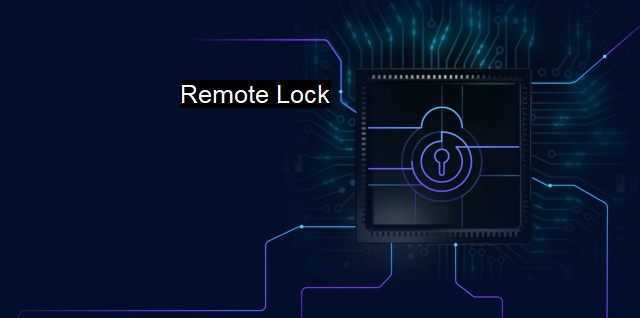What is Remote Lock?
Exploring the Significance of Remote Lock in Cybersecurity: Securing Your Devices from Unauthorized Access and Data Breaches
Remote lock is a popular security tool that enables the locking or disabling of a device from an external location. Remote lock usually applies when a device, such as a laptop or smartphone, is lost, stolen, or misplaced. Remote lock is a security feature that offers protection against potential data breaches or security threats. Remote lock has become an increasingly crucial tool in the cybersecurity landscape as more and more devices become interconnected and reliant upon digital technologies.The concept of remote locking involves the use of a commands or binaries which is installed on the device. This is essentially a preventing measure to deal with lost or unwanted access from unauthorized device or person. With remote locking enabled, once there is any indication that a device is missing, the owner can simply send out the signal via either smartphone, web browser or email prompting the device to instantly switch to Lock Screen Login Screen,” without going through power switch. Essentially, by invoking this command, the device would switch to its sleep mode, otherwise known as ‘Hibernate Mode’ until the lockdown feature expires or until it is manually deactivated by the owner.
Remote lock is one of the crucial parts of the security suite used in cybersecurity and antivirus. Since hackers continuously develop intrusive technologies with entirely new methods of accessing and stealing confidential information, it is up to each system owner to anticipate their methods of cyber-crime and duly put necessary measures in place. The advent of remote locking has been a boon in responsible cybersecurity. When combined with various antivirus tools, remote locking is a powerful deterrent to unauthorized access. Eventually, once a security breach event such as hacking, script kiddie attempt to gain access from unlocked connections, access credentials shared with insider or third parties, remotes and off-site connections comes into the picture by exploiting authentic vulnerable hosts, devices with empty password credentials.
Some of the key challenges facing remote locking can include a lack of consistent detection systems or how to handle security threats prompts some hardware device as overloading,and updates. Organizations must remain vigilant against constantly evolving threats to ensure their remote locking systems remain functional and fully secured. Modern-day antivirus tools such as sound registry editors containing interprocess explorer editor tools, and second-to-none data analysis security are specifically optimised to respond to a range of cyber threats including targeted attacks, malformed worm interpretations, and other classes of malware.
Conclusion:
remote locking and antivirus tools play a crucial role in helping organizations and individuals to protect their devices from potential cyber threats and unauthorized access. The benefits of remote locking are definite, highly concentrated within the cybersecurity suite-meshed environment; the system can be activated via web portals, mobile apps, email, or browser. Its implementation offers real advantages over locking systems, allowing security professionals to investigate, track, test, locate and ideally, retrieve the malware-device appliance which would have gone missing without a second thought nor caution. All trends falling within the malware- device appliance such as user questions, potential improvement drivers etc, must be overruled with perseverance attention from initially dormant management. Although the challenges facing remote locking systems and antivirus tools can be sometimes significant, organizations must remain vigilant in their deployment and administration to ensure continuing protection in an ever changing technological environment. Security professionals understand the workings of encryption-algorithms and the importance of on-going encryption at each stage to prevent bruteforce or submission attacks.

Remote Lock FAQs
What is a remote lock?
A remote lock is a security feature that allows the owner of a device to lock it remotely in case it gets lost or stolen. It is a common feature of antivirus and cybersecurity software designed to prevent unauthorized access to sensitive data.How does a remote lock work?
A remote lock works by sending a command from a remote device or web portal to the target device to lock its screen or disable its functionality. The command typically requires a secure authentication process to prevent unauthorized access.What devices can be remotely locked?
Most modern devices, including smartphones, tablets, laptops, and even desktop computers, can be remotely locked using the appropriate software or app. Some antivirus and cybersecurity solutions also offer remote lock features for connected devices, such as IoT devices and smart home appliances.Is a remote lock enough to protect my data in case of theft?
While a remote lock can prevent unauthorized access to a device, it may not be enough to protect your data from theft. A determined thief could still remove the hard drive, wipe the device, or bypass the lockout feature. To ensure maximum protection of your data, it is recommended to use multiple layers of security measures such as encryption, backup, and remote wipe.| | A | | | B | | | C | | | D | | | E | | | F | | | G | | | H | | | I | | | J | | | K | | | L | | | M | |
| | N | | | O | | | P | | | Q | | | R | | | S | | | T | | | U | | | V | | | W | | | X | | | Y | | | Z | |
| | 1 | | | 2 | | | 3 | | | 4 | | | 7 | | | 8 | | |||||||